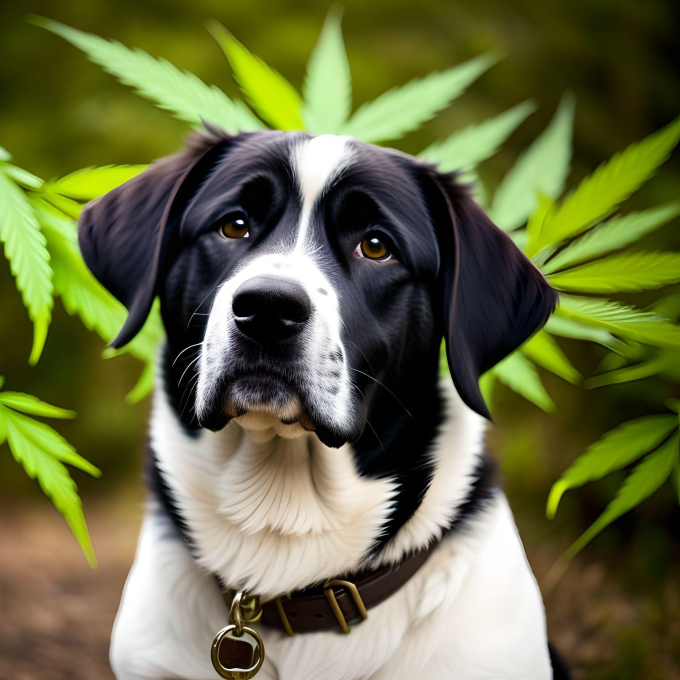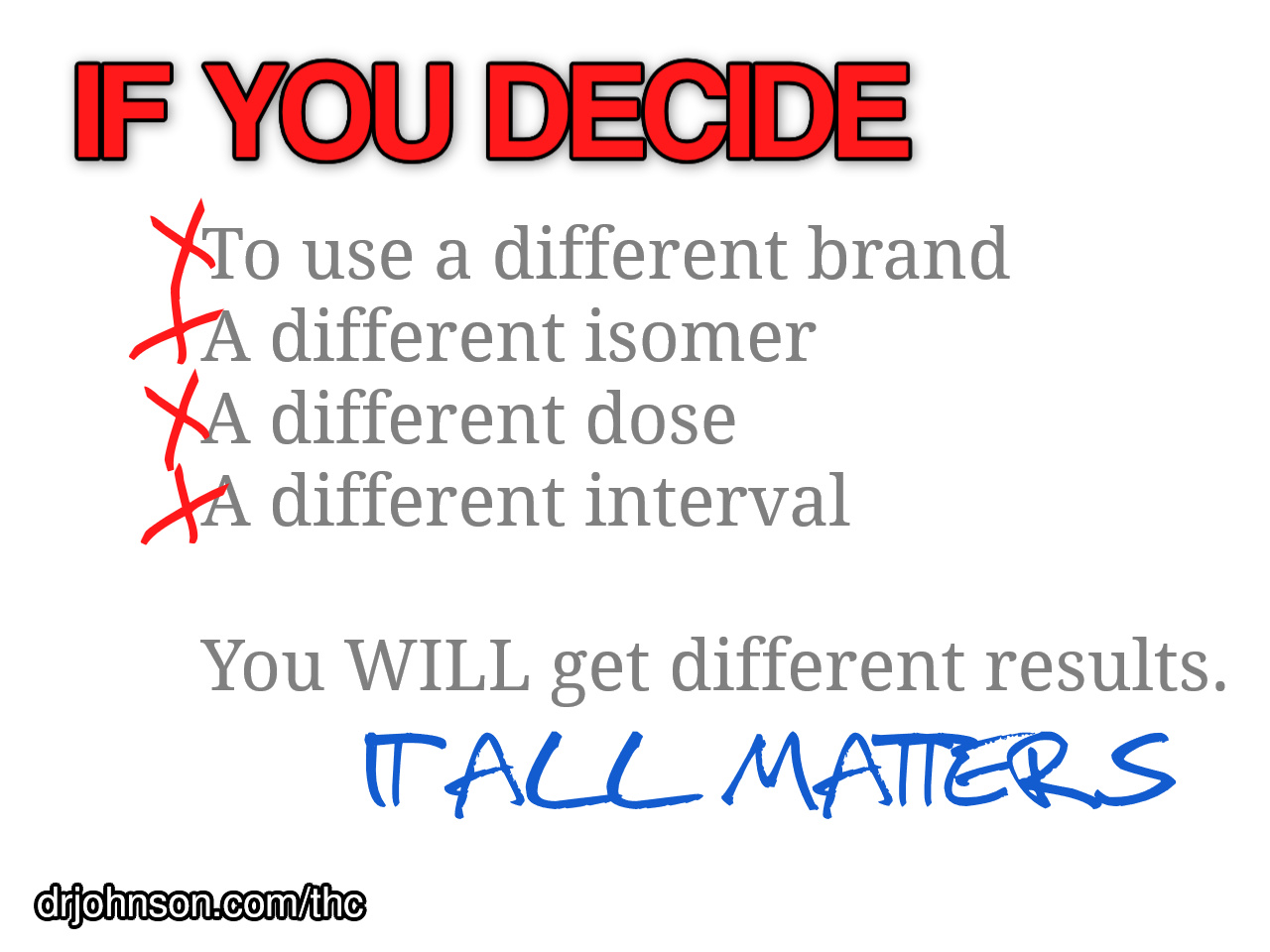THC Delta-8 Cannabinoid Isomer use in Canines / Dogs Marijuana Subpart Dosing Risks
This document is not for random, public consumption. This information does not pertain to your pet unless your veterinarian is explicitly informed and included in your assessment and consumption of this data. THC may have impacts beyond what you can see, for example liver damage*. If for some reason you’re tempted to use this information in relation to your pet, you do so at your own risk. And if your pet is anything less than healthy, you’d be crazy to do so.
*Never, ever documented, example only.
Premise: There are NO articles on the Internet that SPECIFICALLY address the use of THC-Isomer Delta 8 in dogs/canines. There ARE however hundreds of articles that have been AI-mashed up, and TITLED to contain information about THC isomer Delta 8. But they don’t.
Nope. ALL of those articles are mash-ups and rewords, plagiarized variations of practically a SINGLE article that appeared on a University website, which was written by biased or unaware authors providing disinformation thusly:
- That THC Delta 8 Isomer is toxic in dogs.
- That the symptoms of administering ANY dose of THC Delta 8 isomer are identical to dangerous, documented overdosage with THC in-general.
- Reference ONLY articles that highlight the symptoms, doses and management of animals receiving the LD50 of full-spectrum tetra-hydro-cannabinol.
In other words, I found re-hash articles referencing or stemming from one or two documents that purport that Delta 8 in dogs is toxic, but only refer to full-spectrum THC at overdose.
Zero of the articles reference therapeutic doses of Delta-8 THC specifically.
I’m not normally a ‘conspiracy-theorist’ but, the articles seem to be a DISINFORMATION effort to demonize Delta-8 THC Isomer use in dogs simply by attributing research on full-spectrum THC overdose as symptoms of any THC Delta 8 isomer dosing.
I believe there is a financial or regulatory motive. Financial, in that: Practically all instances of this information end up by suggesting the purchase of a “safer” CBD product from the website hosting the articles.
Is Delta 8 THC is dangerous? Nothing could be further from the truth.
In fact, the LD50 of THC Isomer Delta 8 in dogs is THIRTY TIMES the doses that you’d actually use for therapeutic effect in dogs.
Let’s look at Delta 8 use in dogs. Specifically: DELTA 8 isomer of THC, specifically by mouth, specifically in dogs. Not full THC. And not at overdose.
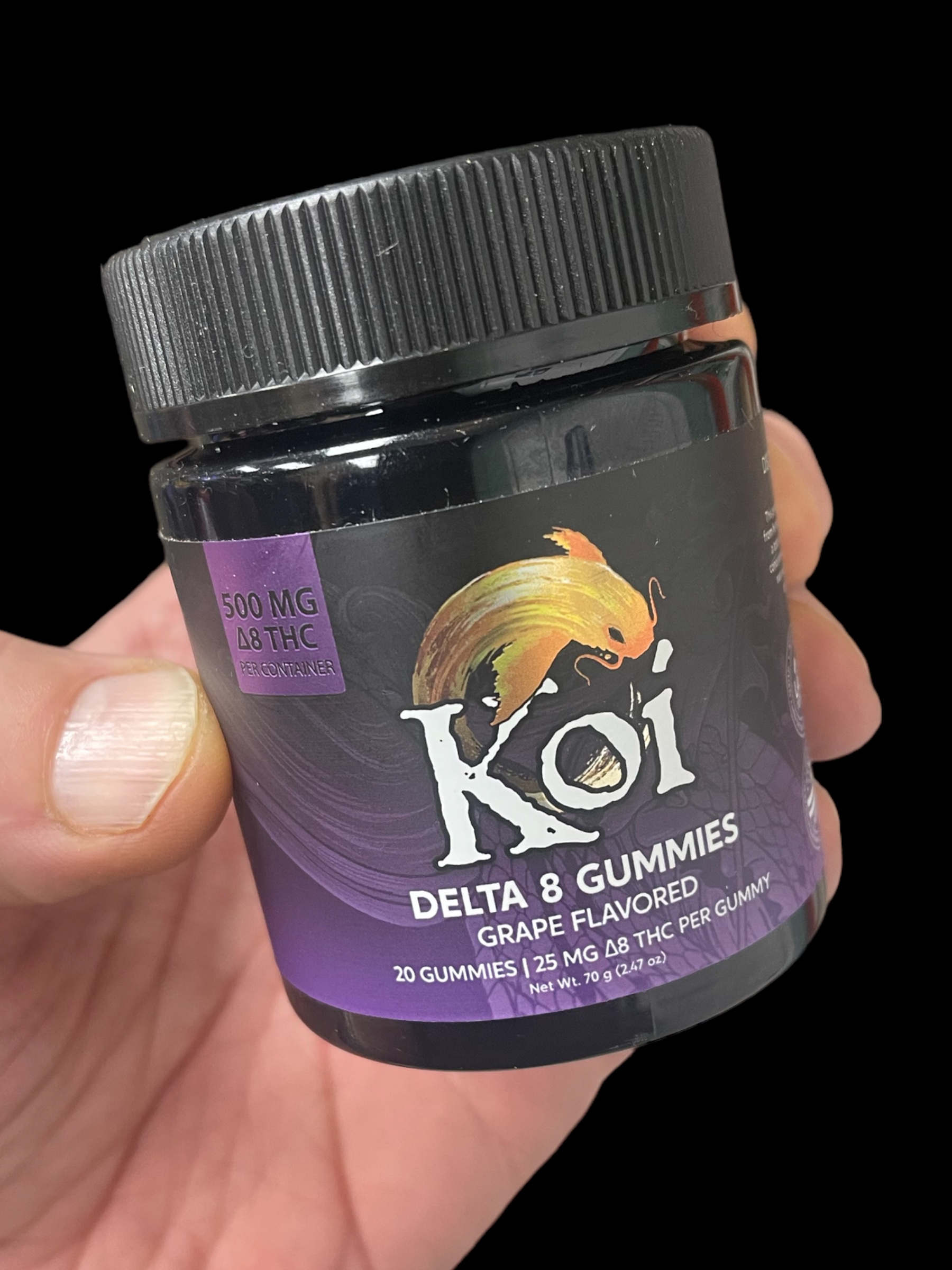
KEY POINTS
- Always start at the lowest dose. This is 0.25mg per kilogram of body weight.
- Effects are seen 60 minutes after dosing.
- Do not use in dogs over 11 years unless under the direct guidance of a Veterinarian.
- Do not use in dogs under 2 years unless under the direct guidance of a Veterinarian.
- The initial phase of mild ataxia / lethargy may be 4 to 5 hours. A ‘calm demeanor’ may last 12-18 hours.
- Drooling is present in all dogs being affected by Delta-8 THC Isomer, and directly proportional to dose. With subsequent dosing this seems to be less-and-less common.
-
If your dog has been sensitive (hard-hit) by other sedatives and tranquilizers, you should assume that your dog might be more sensitive to ECR binding and therefore, more impacted by Delta-8 THC. Go low on the dose. Spread out the interval and titrate UP to an effective amount.
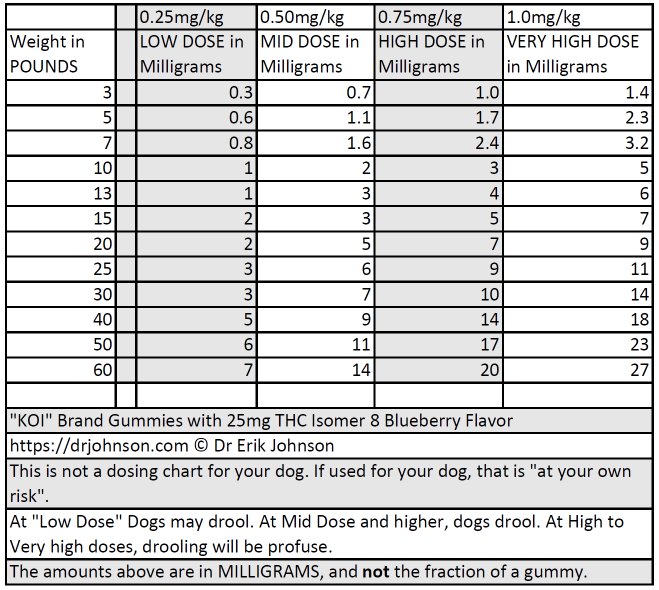
THC DOGS
Compound tested: Delta 8, “Koi” brand, 25mg Gummies: It’s important that the brand, strength and delivery system is consistent.
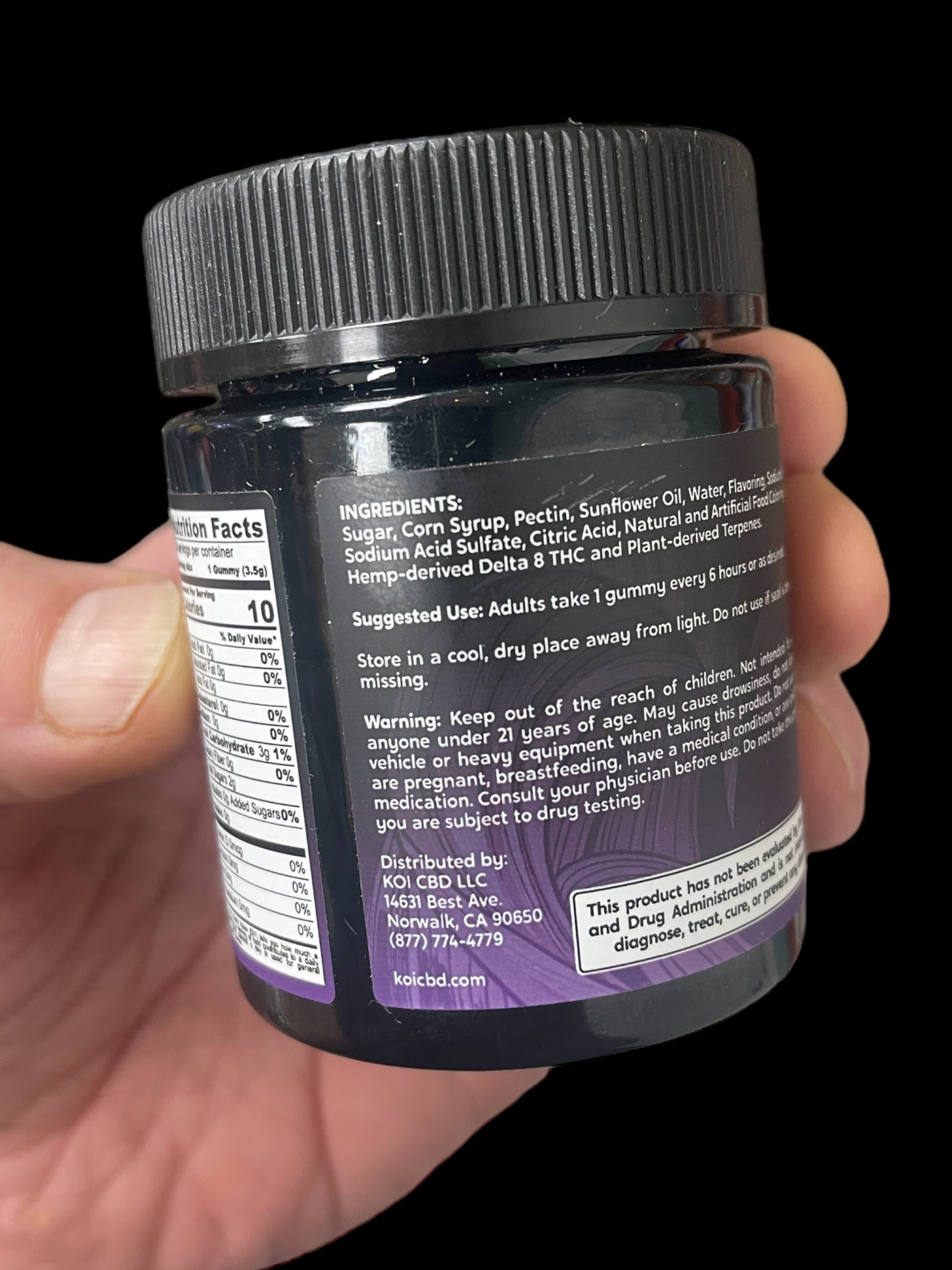
Subject canine did VERY well at 0.5mg/kg and dosed every 5 hours x 2 doses. Another dose was given later, as described.
Pros of Delta 8 Isomer THC: Easy to get. Fairly cheap. Super effective, Safe, Minimal side-effects, Well accepted
Con: Drooling at first, May only lasts five hours?
Third dose given about five hours after the second dose which was given before bed.
Subject dog was down all night. Woke up subdued. Subject is “a morning person dog” and his first “walk” of the day is the dog bursting out the front door by “leaps and bounds” but today it was a walk. Ate fine.
I think I could come to miss the frantic part of his personality. The boundless enthusiasm. I think a person could load a much lower dose and end up giving very little each day.
Questions: If the subject seems “Pretty normal” after five or six hours, are the anticonvulsant or analgesic benefits gone, too?
Hypothesis to test: For lameness from arthritis, need to see if the analgesia lasts longer than the visible symptoms of Delta 8 THC
VISIBLE SIDE EFFECTS of Moderate-Dose Delta-8 THC Given by mouth: (Gummies, by “Koi” Inc. )
VISIBLE Side Effects at 0.5mg/kg (Were Inconsequential)
- 3/4 Dilated pupils
- Some drooling (Not profuse)
- Swaying slightly when standing
- Ate ‘slightly sloppily’
- Threw up scant foam, once, after first dose, not after second or any subsequent dose.
- Bumped head on furniture once (Not hard).
- Bumped into owner’s leg once (Not hard).
THC Delta 8
Basic facts:
- There are four “Deltas” which are all fractional isomers of THC.
- What that means: Regular THC is the combination of four isomers.
- Delta 6 is weak. And fairly “psycho active” means an ingester could get high, but weakly.
- Delta 8 is stronger. But it’s more relaxing and less psychoactive.
- Delta 9 is even stronger but it’s quite psychoactive.
- Delta 10 is stronger than Delta 8 and is a blend of calming and psychedelic.
What we want: We want the dogs to chill and relax. Or not feel any of these “mental” effects at all and just reap the reward of anti-arthritis / pain / epilepsy / glaucoma / anxiety.
We don’t want the dogs to get “high”.
‘Fact is, being “high” can upset some dogs.
The primary side-effect of Delta 8 THC in dogs is drooling.
- If the dog had “plenty” they’ll drool a bit messily.
- If the dog was “just feeling it” they’ll drool a little bit.
- If the dog isn’t high, and isn’t feeling it much, they might not drool.
- The “perfect dose” causes “almost no drooling” and makes the dog very slightly clumsy.
- When a dog has had more than a few doses of THC the drooling may not happen anymore. For example, a dog that has received more than 5 doses in a given week or is “getting used to it”.
Dosing Delta 8 THC.
By-and-large, the dose of THC Delta 8 in canines starts at 1/4mg per kilogram. (0.25mg/kg)
This is “low” for most dogs.
The next dose is “plenty” for regular dogs: 1/2 mg per kilogram. (0.5mg/kg)
There is evidence that a dog could tolerate much more without threat to life or health however; once a dog is drooling, it’s got all it needs for the desired effect whether that’s anti-anxiety or anti-arthritis.
Once a dog is drooling, it’s got all it needs for the desired effect
Drooling = ‘Done’
Re-Dosing
Regular dogs will show a difference in their gait, balance and attention during the first two to five hours of Delta 8 THC.
After 5 hours they are still experiencing anxiolytic impact from the Delta 8 THC which can last fully 12 hours. There is no doubt in my mind that a workable protocol for Delta 8 THC might be:
- 0.5mg/kg by mouth in the morning. 8am
- 0.25mg/kg around noon (8 hours later) 2pm
- And then 0.25mg/kg 8-12 hours after that. 10pm
I think some dogs would do well on 0.5mg/kg by mouth twice a day.
And I think SOME dogs with mild symptoms of anxiety would do fine on 0.5mg/kg by mouth as needed or in the morning.
And as always, if you want less tranquilization, simply dose at 0.25mg/kg
Why use less?
- It’s probable that older and “old” dogs will need LESS. It’s probable that “enough” for an old dog would be the lower 0.25mg/kg dose. Start there.
- It’s probable that dogs that are ALSO on anticonvulsant drugs could need less, and in rare cases MORE.
- I don’t think we’re going to discover that dosing is ‘practically the same’ for every dog, nor that all dogs need as much as other dogs.
- I think all dogs should start Delta 8 THC *no higher than* 0.25mg/kg every 12 hours. Then you can “go up” from there, re-dosing as close as every 6 hours if you want.
Prospects for old and young dogs:
I think Delta 8 THC could be a boon for old dogs. But I think owners should visit their reading-Vet (means they read more than just trade-magazines if at all) and have an old dog checked-out before giving THC. Part of this is because if you find out that your dog has a kidney problem, you don’t assign the issue to the Delta-8 administration. Know what you’re going into, and with what you’re going into it.
Non-reading vets will not check out or be skeptical of the blanket assertion that THC and Delta-8 THC will harm your dog. They will not be of any help.
Titrating Doses
An owner-journal is super-useful (I recommend it very highly) in the dosing of Delta-8 THC in dogs. At least especially at first.
You can record when you gave a dose and how much it was. You can document “onset of signs” and then annotate how long those signs last.
And finally, document when the dog was completely normal again. For my dog “Ajax” he’s finally entirely out of the fog 18 hours after his last dose.
How Do You Know?
When Ajax goes out the door, at the office or at home; he bounds out the door and looks for squirrels that he’s taken by surprise. He’s crisp and alert. Ears up.
When he’s on any dose of Delta 8 THC before 18 hours has elapsed, he walks out the door with a normal posture and gait. I don’t think the agitation of “Squirrel!!” Occurs to him. He just seems nice and calm. Not stuporous.
When to Re-Dose
“My Dog Was “Feeling it” and drooling, and now he’s not”.
After the obvious symptoms of sedation wear off, they can be re-dosed.
It could be recommended that a re-dose at the 5 hour mark would be 0.25mg/kg
But you can re-dose at 0.5mg/kg if you think that’s best. Again, drooling = done.
-
I think most dogs will be ‘best suited’ to re-dosing on an 8 to 12 hour interval.
Some Dogs Need More:
“Out of their mind mailman eating savages” might do better on 0.5mg/kg every 6 to 8 hours until you can do something better.
At that dosing level I’d imagine that drooling would be conspicuous and the fall-risk would be great.
My dog, “Ajax” is 55-60 pounds depending on the day. When we’re going to the boat, he gets restless, and then when he’s actually on the boat: He wanders around whining and goes from seat to seat every 3 to 5 minutes. Very anxious. I give him 0.5mg/kg by mouth about 60 minutes before we arrive at the dock.
Edited July 25th 2023 elj
Added Jul 26, 2023: A dose of 1mg/kg PO was well-tolerated and caused considerably less drooling than when subject was first given Delta 8. Impact was similar in a ‘wobbly’ stance but no difficulty ambulating. After the initial 5-6 hours of visible unsteadiness, the post-dose “mood” impacts remain even 12 hours later: Dog seems “sad” with droopy eyes and the tail wags half as fast. Dog did not spring out of the bed looking for squirrels. Conclusion from this: There should be no reason to ever exceed 1mg/kg in a dog. It would seem to be absolutely safe and the dog could still run around, up and down the stairs. :uD
I really believe that a dog could be loaded at 0.5mg/kg up to 1mg/kg and then 8 hours later, supplemented at 0.25mg/kg as needed to maintain the prevailing calm. Perhaps depending on the anxiety the pet suffers, as rarely as twice a day. Hitting the perfect amount should be ‘relatively easy’ with trial and error, varying interval and amount. I feel that doses above 1mg/kg and intervals closer than 6 hours are unnecessary. -elj
